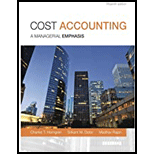
Concept explainers
What is the relationship between management by exception and
Management by Exception:
Management by exception is the process of finding the deviations in the financial and operational outputs of a business and to report the deviations to the management.
Variance Analysis:
Variance analysis is the process of ascertaining the deviations between actual and planned output.
To determine: Relationship between management by exception and variance analysis.
Answer to Problem 7.1Q
The relationship between management by exception and variation analysis is,
- Management by exception is the process of diverting more attention of the management towards underperforming areas and to reduce the attention from the areas working as the expectation of the management.
- Variance analysis produces quantified results of the deviations between predetermined standards or outputs and actual performance.
- Variance analysis suggests the areas that are not performing as per the expectation of the management.
Explanation of Solution
- Variance analysis and management by exception are dependent on each other as variance is used to find the differences in budgeted and actual output and management by exception is used to give more focus on the default areas.
- With variance analysis certain areas causing deviations are identified that eases the work of management.
Thus, variance analysis is used to find the deviation in the performance and management by exception diverts the attention of the management towards underperforming areas.
Want to see more full solutions like this?
Chapter 7 Solutions
EBK COST ACCOUNTING
Additional Business Textbook Solutions
Financial Accounting (12th Edition) (What's New in Accounting)
Principles of Operations Management: Sustainability and Supply Chain Management (10th Edition)
Gitman: Principl Manageri Finance_15 (15th Edition) (What's New in Finance)
Corporate Finance (4th Edition) (Pearson Series in Finance) - Standalone book
Business Essentials (12th Edition) (What's New in Intro to Business)
- Joe and Ethan form JH Corporation. Joe transfers equipment (basis of $210,000 and fair market value of $180,000) while Ethan transfers land (basis of $15,000 and fair market value of $150,000) and $30,000 of cash. Each receives 50% of JH’s stock. As a result of these transfers: a. Joe has a recognized loss of $30,000, and Ethan has a recognized gain of $135,000. b. Neither Joe nor Ethan has any recognized gain or loss.c. Joe has no recognized loss, but Ethan has a recognized gain of $30,000. d. JH Corporation will have a basis in the land of $45,000.e. None of the above.arrow_forwardWhat is the impact of inventory valuation method (FIFO vs. LIFO) on net income during inflation?arrow_forwardPlease provide the answer to this general accounting question with proper steps.arrow_forward
- I need help with this general accounting question using standard accounting techniques.arrow_forwardCan you help me solve this general accounting problem using the correct accounting process?arrow_forwardCan you help me solve this general accounting problem using the correct accounting process?arrow_forward
- Principles of Accounting Volume 2AccountingISBN:9781947172609Author:OpenStaxPublisher:OpenStax College
 Principles of Cost AccountingAccountingISBN:9781305087408Author:Edward J. Vanderbeck, Maria R. MitchellPublisher:Cengage Learning
Principles of Cost AccountingAccountingISBN:9781305087408Author:Edward J. Vanderbeck, Maria R. MitchellPublisher:Cengage Learning Managerial Accounting: The Cornerstone of Busines...AccountingISBN:9781337115773Author:Maryanne M. Mowen, Don R. Hansen, Dan L. HeitgerPublisher:Cengage Learning
Managerial Accounting: The Cornerstone of Busines...AccountingISBN:9781337115773Author:Maryanne M. Mowen, Don R. Hansen, Dan L. HeitgerPublisher:Cengage Learning  Cornerstones of Cost Management (Cornerstones Ser...AccountingISBN:9781305970663Author:Don R. Hansen, Maryanne M. MowenPublisher:Cengage LearningBusiness Its Legal Ethical & Global EnvironmentAccountingISBN:9781305224414Author:JENNINGSPublisher:Cengage
Cornerstones of Cost Management (Cornerstones Ser...AccountingISBN:9781305970663Author:Don R. Hansen, Maryanne M. MowenPublisher:Cengage LearningBusiness Its Legal Ethical & Global EnvironmentAccountingISBN:9781305224414Author:JENNINGSPublisher:Cengage Accounting Information SystemsAccountingISBN:9781337619202Author:Hall, James A.Publisher:Cengage Learning,
Accounting Information SystemsAccountingISBN:9781337619202Author:Hall, James A.Publisher:Cengage Learning,





